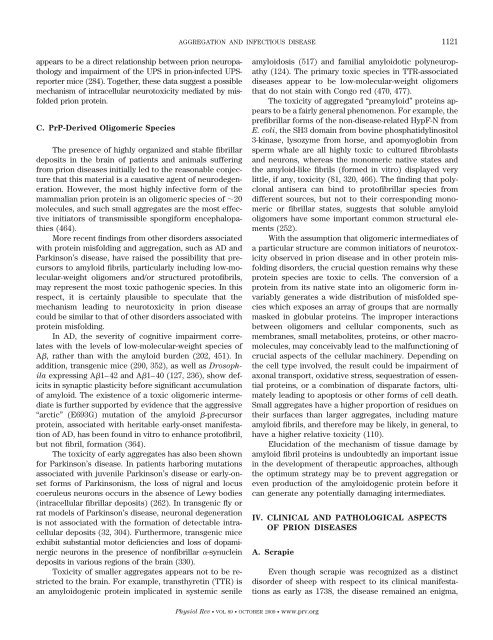Prions: Protein Aggregation and Infectious Diseases - Physiological ...
Prions: Protein Aggregation and Infectious Diseases - Physiological ...
Prions: Protein Aggregation and Infectious Diseases - Physiological ...
Create successful ePaper yourself
Turn your PDF publications into a flip-book with our unique Google optimized e-Paper software.
appears to be a direct relationship between prion neuropathology<br />
<strong>and</strong> impairment of the UPS in prion-infected UPSreporter<br />
mice (284). Together, these data suggest a possible<br />
mechanism of intracellular neurotoxicity mediated by misfolded<br />
prion protein.<br />
C. PrP-Derived Oligomeric Species<br />
The presence of highly organized <strong>and</strong> stable fibrillar<br />
deposits in the brain of patients <strong>and</strong> animals suffering<br />
from prion diseases initially led to the reasonable conjecture<br />
that this material is a causative agent of neurodegeneration.<br />
However, the most highly infective form of the<br />
mammalian prion protein is an oligomeric species of 20<br />
molecules, <strong>and</strong> such small aggregates are the most effective<br />
initiators of transmissible spongiform encephalopathies<br />
(464).<br />
More recent findings from other disorders associated<br />
with protein misfolding <strong>and</strong> aggregation, such as AD <strong>and</strong><br />
Parkinson’s disease, have raised the possibility that precursors<br />
to amyloid fibrils, particularly including low-molecular-weight<br />
oligomers <strong>and</strong>/or structured protofibrils,<br />
may represent the most toxic pathogenic species. In this<br />
respect, it is certainly plausible to speculate that the<br />
mechanism leading to neurotoxicity in prion disease<br />
could be similar to that of other disorders associated with<br />
protein misfolding.<br />
In AD, the severity of cognitive impairment correlates<br />
with the levels of low-molecular-weight species of<br />
A, rather than with the amyloid burden (202, 451). In<br />
addition, transgenic mice (290, 352), as well as Drosophila<br />
expressing A1–42 <strong>and</strong> A1–40 (127, 236), show deficits<br />
in synaptic plasticity before significant accumulation<br />
of amyloid. The existence of a toxic oligomeric intermediate<br />
is further supported by evidence that the aggressive<br />
“arctic” (E693G) mutation of the amyloid -precursor<br />
protein, associated with heritable early-onset manifestation<br />
of AD, has been found in vitro to enhance protofibril,<br />
but not fibril, formation (364).<br />
The toxicity of early aggregates has also been shown<br />
for Parkinson’s disease. In patients harboring mutations<br />
associated with juvenile Parkinson’s disease or early-onset<br />
forms of Parkinsonism, the loss of nigral <strong>and</strong> locus<br />
coeruleus neurons occurs in the absence of Lewy bodies<br />
(intracellular fibrillar deposits) (262). In transgenic fly or<br />
rat models of Parkinson’s disease, neuronal degeneration<br />
is not associated with the formation of detectable intracellular<br />
deposits (32, 304). Furthermore, transgenic mice<br />
exhibit substantial motor deficiencies <strong>and</strong> loss of dopaminergic<br />
neurons in the presence of nonfibrillar -synuclein<br />
deposits in various regions of the brain (330).<br />
Toxicity of smaller aggregates appears not to be restricted<br />
to the brain. For example, transthyretin (TTR) is<br />
an amyloidogenic protein implicated in systemic senile<br />
AGGREGATION AND INFECTIOUS DISEASE 1121<br />
amyloidosis (517) <strong>and</strong> familial amyloidotic polyneuropathy<br />
(124). The primary toxic species in TTR-associated<br />
diseases appear to be low-molecular-weight oligomers<br />
that do not stain with Congo red (470, 477).<br />
The toxicity of aggregated “preamyloid” proteins appears<br />
to be a fairly general phenomenon. For example, the<br />
prefibrillar forms of the non-disease-related HypF-N from<br />
E. coli, the SH3 domain from bovine phosphatidylinositol<br />
3-kinase, lysozyme from horse, <strong>and</strong> apomyoglobin from<br />
sperm whale are all highly toxic to cultured fibroblasts<br />
<strong>and</strong> neurons, whereas the monomeric native states <strong>and</strong><br />
the amyloid-like fibrils (formed in vitro) displayed very<br />
little, if any, toxicity (81, 320, 466). The finding that polyclonal<br />
antisera can bind to protofibrillar species from<br />
different sources, but not to their corresponding monomeric<br />
or fibrillar states, suggests that soluble amyloid<br />
oligomers have some important common structural elements<br />
(252).<br />
With the assumption that oligomeric intermediates of<br />
a particular structure are common initiators of neurotoxicity<br />
observed in prion disease <strong>and</strong> in other protein misfolding<br />
disorders, the crucial question remains why these<br />
protein species are toxic to cells. The conversion of a<br />
protein from its native state into an oligomeric form invariably<br />
generates a wide distribution of misfolded species<br />
which exposes an array of groups that are normally<br />
masked in globular proteins. The improper interactions<br />
between oligomers <strong>and</strong> cellular components, such as<br />
membranes, small metabolites, proteins, or other macromolecules,<br />
may conceivably lead to the malfunctioning of<br />
crucial aspects of the cellular machinery. Depending on<br />
the cell type involved, the result could be impairment of<br />
axonal transport, oxidative stress, sequestration of essential<br />
proteins, or a combination of disparate factors, ultimately<br />
leading to apoptosis or other forms of cell death.<br />
Small aggregates have a higher proportion of residues on<br />
their surfaces than larger aggregates, including mature<br />
amyloid fibrils, <strong>and</strong> therefore may be likely, in general, to<br />
have a higher relative toxicity (110).<br />
Elucidation of the mechanism of tissue damage by<br />
amyloid fibril proteins is undoubtedly an important issue<br />
in the development of therapeutic approaches, although<br />
the optimum strategy may be to prevent aggregation or<br />
even production of the amyloidogenic protein before it<br />
can generate any potentially damaging intermediates.<br />
IV. CLINICAL AND PATHOLOGICAL ASPECTS<br />
OF PRION DISEASES<br />
A. Scrapie<br />
Physiol Rev VOL 89 OCTOBER 2009 www.prv.org<br />
Even though scrapie was recognized as a distinct<br />
disorder of sheep with respect to its clinical manifestations<br />
as early as 1738, the disease remained an enigma,











